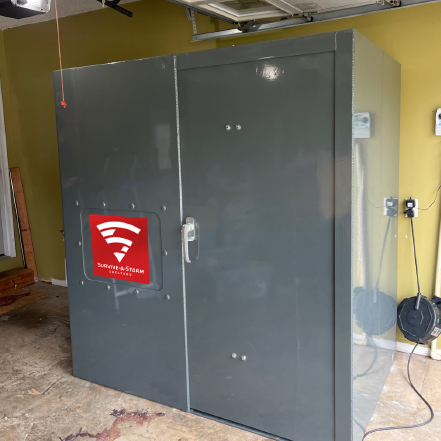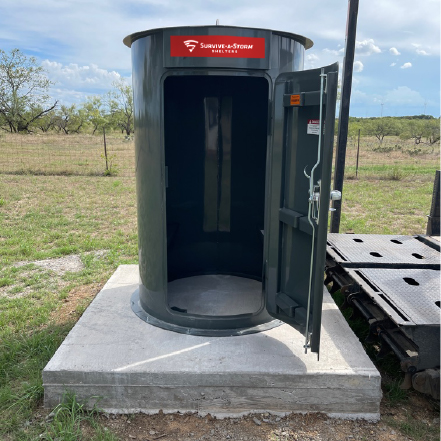CATEGORIES:
How to Make a Family Tornado Safety Plan Kids Will Actually Follow: Steps That Cut Panic And Save Time
November 12, 2025

Looking for a family tornado safety plan your kids can actually follow without spending all weekend on it? The goal is simple: when the threat of a tornado or severe thunderstorm looms, every family member knows where to go, what to grab, and how to communicate. There should be no debates, no scrambling, and no “where are my pants?” during a siren.
What Is A Family Tornado Safety Plan And Why It Matters
A family tornado safety plan is a short, repeatable script that tells each of your loved ones where to shelter, what to bring, and how to check in. It should be written so children can use it under the stress of a weather disaster and so your community or neighborhood officials could follow it if they need to help.
Why it matters: the average U.S. tornado warning lead time is around 13 minutes, which means families have to move fast, on autopilot. A clear script reduces panic because kids recognize the steps, like a school routine: helmet, shoes, go bag, shelter spot, quiet bodies.
Picture the moment that sirens start, the dog starts barking, hail pings the windows, and cereal bowls rattle on the counter. With a plan, your kids already know what to do, and familiarity lowers fear and anxiety.
Visual checklists help younger children and neurodivergent learners succeed without extra prompts. Assigning small jobs like “you grab the flashlight” and “you hold the dog’s leash” creates buy-in and better recall.
Tornado Alerts Explained: What A Watch, A Warning, And A Tornado Emergency Mean
Understanding the three types of tornado alerts helps your family react quickly and confidently. Each alert signals a different level of urgency. Knowing what they mean is a core part of any family tornado safety plan and directs you to pay attention to local systems that track storms.
Wireless Emergency Alerts reach phones automatically, and NOAA Weather Radio triggers a loud alert, even overnight. Sirens vary by county policy, which means some neighbors might hear them when others do not. When in doubt, act on the most urgent alert you see or hear.
What to Do During a Tornado Watch
 A tornado watch means conditions are right for tornadoes. This is a good time for families to take precautions. They can prepare by charging devices, moving helmets and sturdy shoes to the shelter route, and placing the go bag near your shelter space. Watch for changing signs in the sky, like dark cloud rotation and strong winds, listen for thunder. Follow FEMA or local state guidance for updates in advance of the storm.
A tornado watch means conditions are right for tornadoes. This is a good time for families to take precautions. They can prepare by charging devices, moving helmets and sturdy shoes to the shelter route, and placing the go bag near your shelter space. Watch for changing signs in the sky, like dark cloud rotation and strong winds, listen for thunder. Follow FEMA or local state guidance for updates in advance of the storm.
Review the plan with your kids: “Helmet, shoes, bag, closet.”
If you live in a mobile home, relocate early to a sturdy building that you’ve identified ahead of time. This is especially helpful during nighttime watches when sleep slows reaction time and you may not be monitoring the news for disasters.
What to Do During a Tornado Warning
A tornado warning means a tornado is happening or imminent.
During a tornado warning, a family should immediately move to shelter, grabbing the go bag on the way. Cover heads and necks with helmets and a mattress or heavy blankets. Stay until the warning expires or a second alert says the danger has passed.
What a Tornado Emergency Means for Families
A tornado emergency is the highest-level alert for a confirmed, dangerous tornado in a populated area.
During a tornado emergency, a family should take the fastest available protective action with no delay. If at home, move to the shelter room and brace with helmets and a mattress. If in a vehicle or parking lot, abandon the vehicle for the nearest sturdy building; do not try to outrun the storm in city traffic. If outdoors with no building, lie flat on the ground in a low spot as a last resort and protect the head.
Key Insight: A watch means “get set,” a warning means “go now,” and an emergency means “maximum protection, immediately.” Treat the wording as the green-yellow-red light system for your plan.
How To Choose The Safest Place To Shelter at Home When You Don’t Have a Tornado Shelter
If you do not have a hardened tornado shelter, the safest place to shelter in a house is a small interior room on the lowest level with no windows. This puts multiple walls and structural layers between the family and flying debris. A small, central space beats a large room on an exterior wall. Protect the head and neck; most tornado-related injuries happen there.
Families often ask about bathrooms and closets. And in many homes, a small internal room is, indeed, a bathroom. If it’s centrally located and windowless, use it. A closet under a staircase can be excellent too, since stair framing adds structure. A hallway corner also works if it sits far from exterior glass.
Tile floors can feel cold on knees, so store a folded blanket or yoga mat inside. Stash a bike helmet for each person on a hook and a pair of sturdy shoes nearby to avoid stepping on nails and broken picture frame glass after the storm. Add a mattress or thick blankets to protect against falling objects. You can shave off seconds by moving these items close by during the tornado watch or while you're keeping an eye on storms in another watch area
If You Have A Basement or Storm Cellar
While older homes sometimes have dedicated outdoor storm cellars, most modern basements are inside the home, though they might not be hardened tornado shelters. Even so, they’re often still the best place to ride out a storm. If debris or high winds tear at roofs or windows, being underground offers greater protection than anywhere else in your home.
Use the area under a stairwell or an interior corner away from the basement windows and doors. Keep kids against a wall, low and covered. Head protection matters, so helmets go on first. Avoid exterior windows that break and become glass shards.
Important: Do not open windows. Opening windows does not equalize pressure or reduce damage. It wastes precious seconds. Flying debris and pressure differences shatter glass either way, and shattered glass can cause foot and head injuries.
Where to Shelter In Apartments, Mobile Homes, And Dorms
Tornado safety in apartments, mobile homes, and dorms means picking a safe interior space and planning the fastest route. The plan needs a clock: relocating during a watch or early in a warning saves minutes when elevators shut down or parking lots are gridlocked.
Upper floors and manufactured housing carry a higher risk. In apartments and multi-story buildings, choose interior stairwells or interior rooms on the lowest level. Skip elevators during warnings. Avoid glass atriums and exterior corridors. If a building has a labeled shelter room, memorize the route; practice walking it once so kids remember the turns.
Residents of mobile homes and manufactured housing should know that they do not offer reliable protection from tornado winds, which makes relocating to a pre-identified sturdy shelter the right strategy in keeping your family secure. Identify a community safe room, church, or neighbor’s home within a short drive, or a safe walking route if storms block roads or ditches flood. Keep car keys, a go bag, and pet carriers by the door for evacuation when a watch goes up, not after a warning arrives.
Dorms and campus housing usually assign interior hallways or stairwells as the sheltering area. Learn the campus alert system and register phones. Ask Resident Advisors, or the Residence Hall Directors about the storm plan or tornadoes.
How To Include Babies, Elders, And People With Disabilities
A tornado plan for babies, elders, and people with disabilities must include assitance with mobility transfers, accessible routes, medication access, sensory supports, and caregiver roles, so every person can move quickly and stay calm. Pre-stage equipment inside the shelter space so nothing blocks the door when time is short. Keep contact information for doctors, pharmacies, and services handy in case of medical emergencies.
Mobility And Medical Needs
Decide the transfer method early. The wheelchair can stay at the doorway while the person shelters on a low seat or a folded camp chair inside the small room. Keep a spare charger or small battery for powered devices and a paper medication list with dosages in the go bag. If oxygen or other medical equipment is required, have extra hose and a backup power plan. Clear thresholds and rugs along the shelter route so wheels do not catch when seconds matter.
Sensory and Neurodivergent Support When Sheltering from Storms
Sensory-friendly plans help. Store noise-reduction earmuffs, a small fidget tool, and a familiar comfort item in the shelter. Use predictable scripts and a visual schedule so a child can point and repeat: “Helmet, shoes, bag, closet.” Practice the body position: knees tucked, head covered, so the posture feels familiar, not scary.
Service Animals And Pets For Owners Who Have Disabilities
Keep a labeled harness and ID on the animal at all times during watches. Practice sheltering together in the chosen room so the space feels routine to the animal. A pet mat on the floor creates a “place” cue that calms anxious dogs when thunder booms and sirens start.
Making A Tornado Safety Plan Kids Will Follow
A kid-friendly tornado plan works when the steps are visual, the language is short, and the routine matches school drills that children already know. Kids perform better with “show me” over “tell me,” which means icons and a one-page schedule beat long explanations.
Create A One-Page Visual Schedule
Print a simple sheet with four to five icons: helmet, shoes, go bag, route arrows, and the shelter room picture. Tape it low on a wall so small children can see it and point to each step. Laminate it or slip it in a sheet protector so it survives juice splashes and kitchen steam.
Use Call-and-Response Scripts That Match School Drills
Teach a mantra with three to five steps that kids can repeat with you. Example: “Helmet, shoes, bag, closet, quiet.” Matching words to actions helps the body move even when the road of thunder rattles the house.
Ask teachers or the school counselor which cues and body positions kids practice. Use the same posture at home: low, facing the interior wall, head covered, arms shielding the head. Familiar cues cut through adrenaline and shave seconds off the time it takes to wake the household at 2 a.m.
What To Pack In A Tornado Go Bag
Keep your tornado go bag lightweight, organized, and staged where it’s easy to grab. A family tornado go bag should hold copies of ID, medications, water, flashlights, chargers, whistles, sturdy shoes, helmets for head protection, and a simple pet kit. Essential supplies should be within reach when alerts sound. A $25 power bank can keep your phone charged when the grid is down during a power outage. A lightweight backpack parked on the shelter route keeps hands free for guiding kids and pets.
Why Helmets and Shoes Matter During a Tornado
Head injuries drive a large share of tornado fatalities among people sheltering in buildings without a hardened room. A $20–$60 bike helmet can dramatically lower that risk. Sturdy shoes prevent puncture wounds from nails and glass after the storm, and missing daily medications can turn into an after-hours pharmacy scramble or an ER visit.
What Else to Include in Your Tornado Go-Bag
Adults: Photocopies of IDs and insurance cards, prescription meds with a printed list, flashlight or headlamp with extra batteries, a whistle, $20-$60 in small bills, a charged power bank and cords, one liter of water per person, and a compact first-aid kit with bandages and antiseptic wipes.
Kids: A labeled helmet, slip-on sturdy shoes, a comfort item, a non-melting snack, and an emergency contact card with names and phone numbers.
Pets: Leash or harness, a collapsible bowl, a two-day food and water supply, vaccination records, and a soft carrier for small dogs or cats.
Extras: A mini-kit for a desk or locker (with a copy of the contact card) and a second kit in the car for after-school pickups or commutes during active weather.
Pro Tip: Stage helmets and shoes on the shelter route, not in the garage. A cheap over-door hook set inside the shelter room stores four helmets and a small flashlight, so kids can gear up without hunting.
How To Practice Tornado Drills At Home
Short, calm tornado drills help build muscle memory and reduce panic. Treat them like a routine, not an emergency. A family that practices can move faster and stay focused when it counts.
Time Tornado Drills Like a Game—Then Track Your Progress
Keep each drill short and calm. Set a goal to reach the shelter in two minutes or less. Use a timer on your phone or kitchen clock. Record your time and challenge the family to beat it next round. Turning it into a game keeps kids engaged without fear.
Run monthly drills in the off-season and weekly during peak weeks in spring or fall. Each drill should include the start signal, route, position, and a 30-second head-cover practice in the shelter room.
Assign Tornado Drill Roles to Cut Chaos and Build Confidence
Give each person a job with a one-line description. One adult grabs the go bag. One older child clips the dog leash. One adult counts heads in the shelter room. Roles reduce shouting because the job tells each person where to focus.
FAQ: Should parents wake kids for an overnight tornado warning?
A: Yes. A tornado warning means shelter immediately, day or night. Store helmets and slip-on shoes by the bed during active weather so nighttime moves feel simple and fast.
Communication Plans That Keep Families Connected During Tornadoes
A family communication plan helps everyone know where to go and how to reconnect if you get separated. Phones may lose signal, power can go out, and alerts might fail—so simple, repeatable steps work best.
Set a Shelter Spot, Meeting Place, and Text Contact
At home, everyone should know where to shelter. After the storm, power and service may be down, so text rather than call. Texts use less bandwidth and often go through when calls don’t.
If you’re in the car or outside, move to the nearest sturdy building. Never shelter under a bridge or overpass. Wind speeds increase in the funnel, and debris can turn deadly. If no building is nearby, lie flat in a low area and protect your head.
At school, work, or in a store, follow on-site instructions. Move to interior hallways or rooms away from glass. In large stores, restrooms or stockrooms often provide the best protection.
How To Set A Meeting Place And A Communication Plan
Choose a nearby outdoor meeting spot—a neighbor’s porch or a specific tree on the next block—away from power lines and trees. Pick an out-of-area contact so everyone will have someone to text if local networks are jammed. Write the number on emergency cards for kids’ backpacks and wallets. Keep a power bank in the go bag and another in the car. Location-sharing apps can help, but always have a backup written plan in case batteries die or service is lost.
Templates, Checklists, And Spanish Resources You Can Use
Families move faster with printables. A one-page visual schedule, a tornado plan checklist PDF, and a simple family contact form give babysitters and grandparents the same playbook. Share copies with daycare, after-school programs, and coaches so pickup adults know the shelter room and the outside meeting spot.
The National Weather Services isn't just a resource for English speakers. For Spanish-speaking households, the National Weather Service offers guidance in NWS en Español, and Ready.gov provides printable family emergency plan forms in Spanish and other languages.
A bilingual version of your visual schedule helps kids practice both at home and school. Familiar words and icons build confidence and cut response time when alerts sound.
FAQ: How long should a family stay in the shelter after the warning?
A: Stay until the warning expires on an official source like NOAA Weather Radio or a trusted weather app, then check a second alert source. Some events produce back-to-back warnings, leaving early risks exposure to the next cell.
Real Talk About Why Having a Family Tornado Safety Plan Matters
Getting your family tornado safety plan right isn’t about over-preparing. It’s about removing panic from the moment that counts. Every minute, every step, and every habit make a difference for families in the Midwest and other storm-prone communities.
- Time stakes: shaving 60 seconds off a drill can erase almost 8% of the average 13-minute warning lead time. That minute decides whether helmets make it on heads.
- Physical stakes: sturdy shoes prevent puncture wounds from nails and shattered glass; helmets protect against head injury risk from falling debris.
- Money stakes: a $25 power bank and a $40 set of child helmets cost less than one urgent care visit after stepping on a screw or missing medications during an outage.
- Emotional stakes: clear roles stop shouting under pressure. The result? Calmer kids and a faster route to safety.
- Opportunity cost: leaving a mobile home during a watch takes 10–15 minutes; waiting until a warning might mean a blocked exit and a dangerous scramble.
For more storm preparedness tips, or if you’d like more information about tornado shelter options, reach out to us today. We are ready to answer questions and discuss the best tornado shelter solution for your needs.







